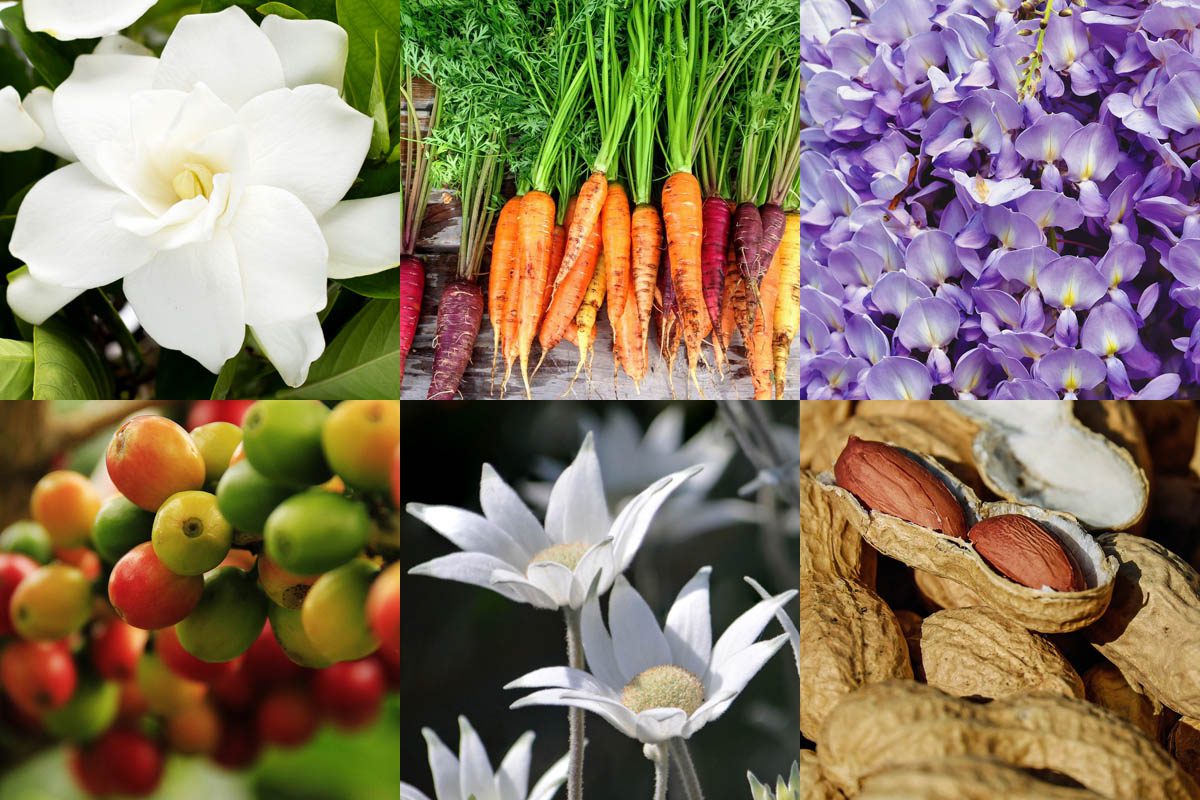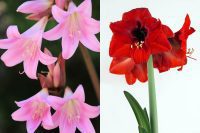Plant classification involves the identification and categorisation of plants based on their physical and genetic characteristics. This system of classification, known as taxonomy, consists of several hierarchical categories or ranks, including Kingdom, Phylum, Class, Order, Family, Genus, and Species.
The plant family is a higher taxonomic rank than species. A family is a group of several related plants that share common characteristics and are classified under the same group. It includes multiple genera (plural of genus), and a genus may include multiple species. For instance, the Rosaceae family includes many different genera, such as Rosa (roses), Malus (apples), and Prunus (cherries, peaches, and plums), among others.
Species is the most basic unit of classification and represents a group of plants that have similar physical characteristics and can interbreed to produce fertile offspring. For example, within the Rosa genus, there are multiple species like Rosa canina (dog rose) and Rosa rubiginosa (sweet briar).
You may notice the letter L after the botanical name of some plants, for example, the red maple (Acer rubrum L.). This tells us that the plant was named by Carl Linnaeus, the Swedish botanist, physician, and zoologist who formalised binomial nomenclature, and is known as the “father of modern taxonomy“.
Flannel flower and carrots
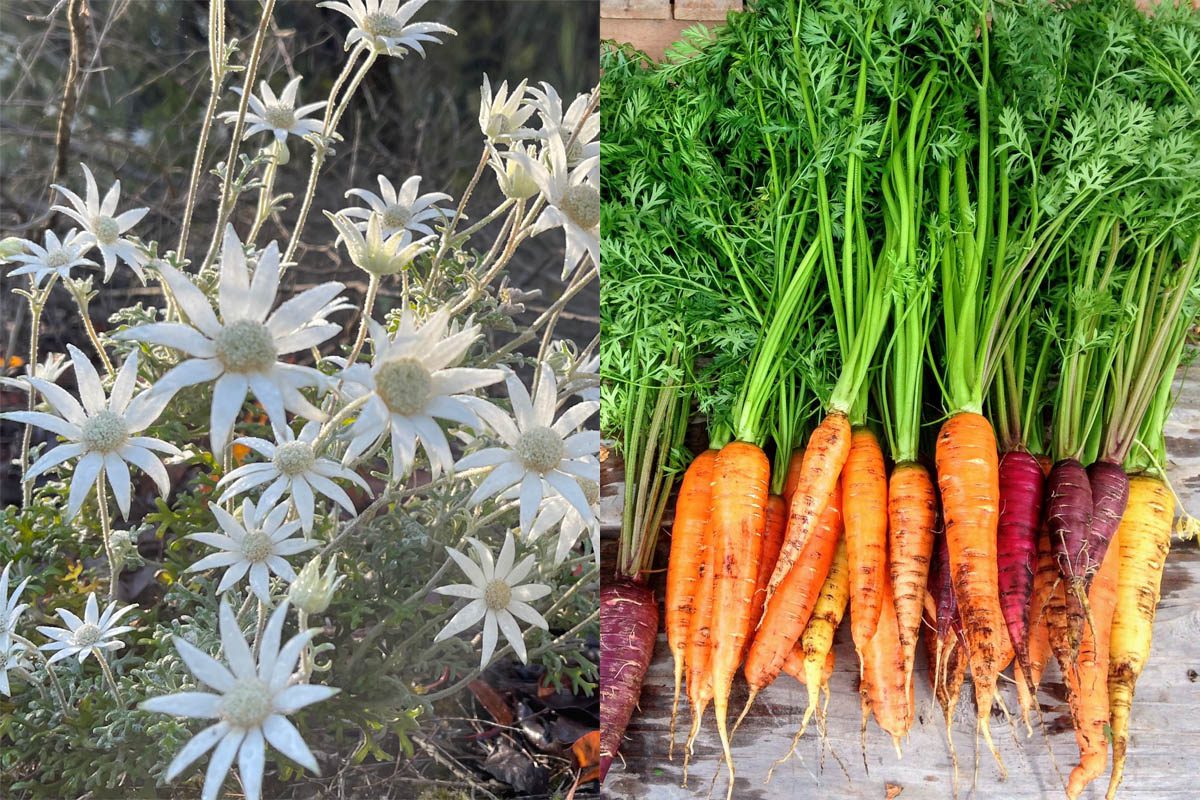
Flannel flowers (Actinotus helianthi) and carrots (Daucus carota subsp. sativus) are both members of the family Apiaceae, commonly known as the carrot or parsley family. This diverse plant family comprises about 434 genera and nearly 3,700 species, with members found all over the world, indicating a broad ability to adapt to various climates and conditions. The Apiaceae family is characterised by its unique inflorescence structure known as an umbel—a flat-topped or rounded flower cluster in which the individual flower stalks arise from the same point, much like the ribs of an umbrella.
- Flannel flowers are native to Australia and carrots originally hail from parts of Europe and southwestern Asia, they share key family traits that underline their common evolutionary lineage.
- Carrots are root vegetables, usually orange in colour, known for their crisp texture when fresh, and a high content of beta-carotene, which is metabolised into vitamin A in humans.
Flannel flowers and carrots exhibit compound leaves, another shared characteristic within the family. The global distribution of Apiaceae is likely due to the ability of their seeds to disperse over long distances, perhaps carried by wind, water, or hitching a ride with animals. Over time, these plants have adapted to their specific environments, resulting in the diverse array of species we see today.
Other notable members of the Apiaceae family include parsley, dill, celery, coriander, parsnip and caraway.
Wisteria and peanuts
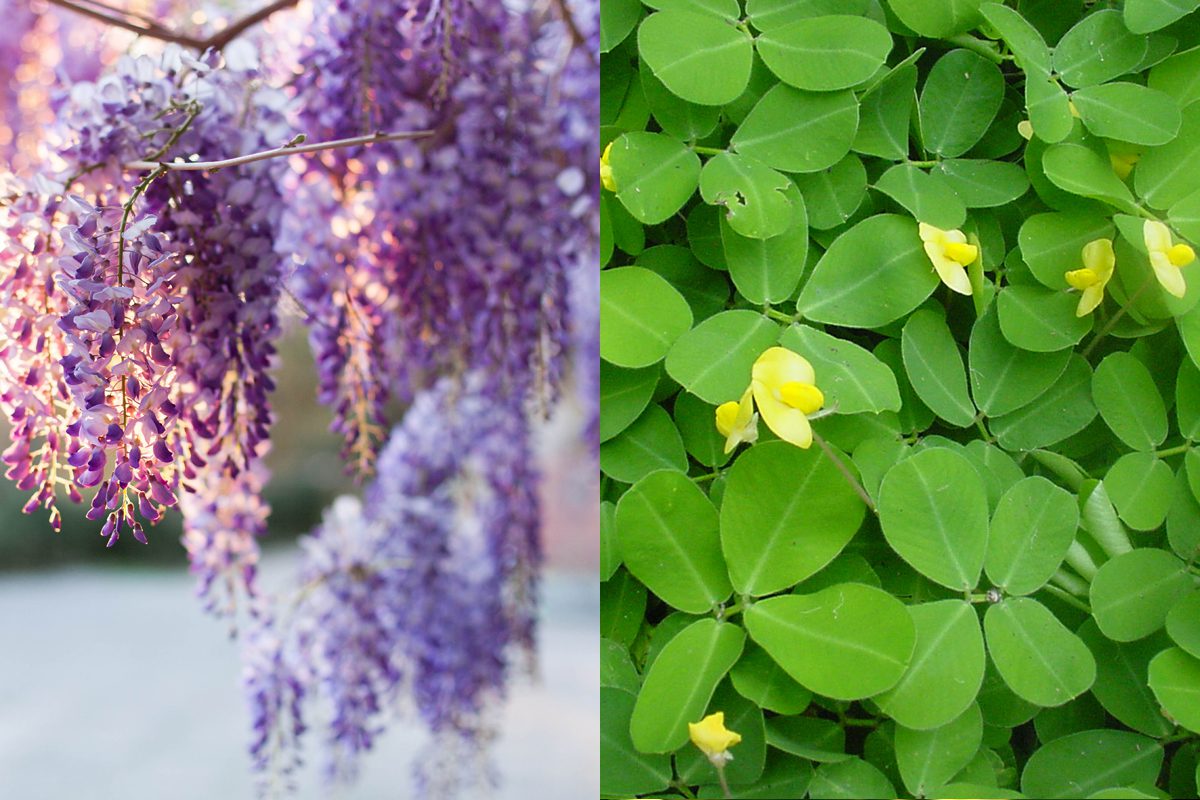
Peanut plant photo Rae Allen, Flickr
Both wisteria (Wisteria species) and peanuts (Arachis hypogaea) belong to the large and diverse Fabaceae family, also known as the legume, pea or bean family. This family comprises over 19,000 species spread across 750 genera and is one of the largest plant families in the world.
The Fabaceae family has a worldwide distribution, indicating a long evolutionary history that likely involved extensive dispersal and adaptation to various environments. Genetic studies have shown that the family’s divergence began in the early Cretaceous period, approximately 100 million years ago.
- Wisteria is a genus of woody climbing vines native to the Eastern United States and to China, Korea, and Japan. They are popular for their cascading flower clusters, often in shades of blue and purple. Wisterias are a staple in many ornamental gardens due to their stunning display and strong, sweet fragrance.
- The peanut plant is a leguminous crop known for its edible seeds, which grow in a unique manner by developing underground after the flowers are pollinated and the stalk bends down to bury them in the soil.
Other notable members of the Fabaceae family: Chickpea, lentil, clover and lupin.
Sweet potato and morning glory
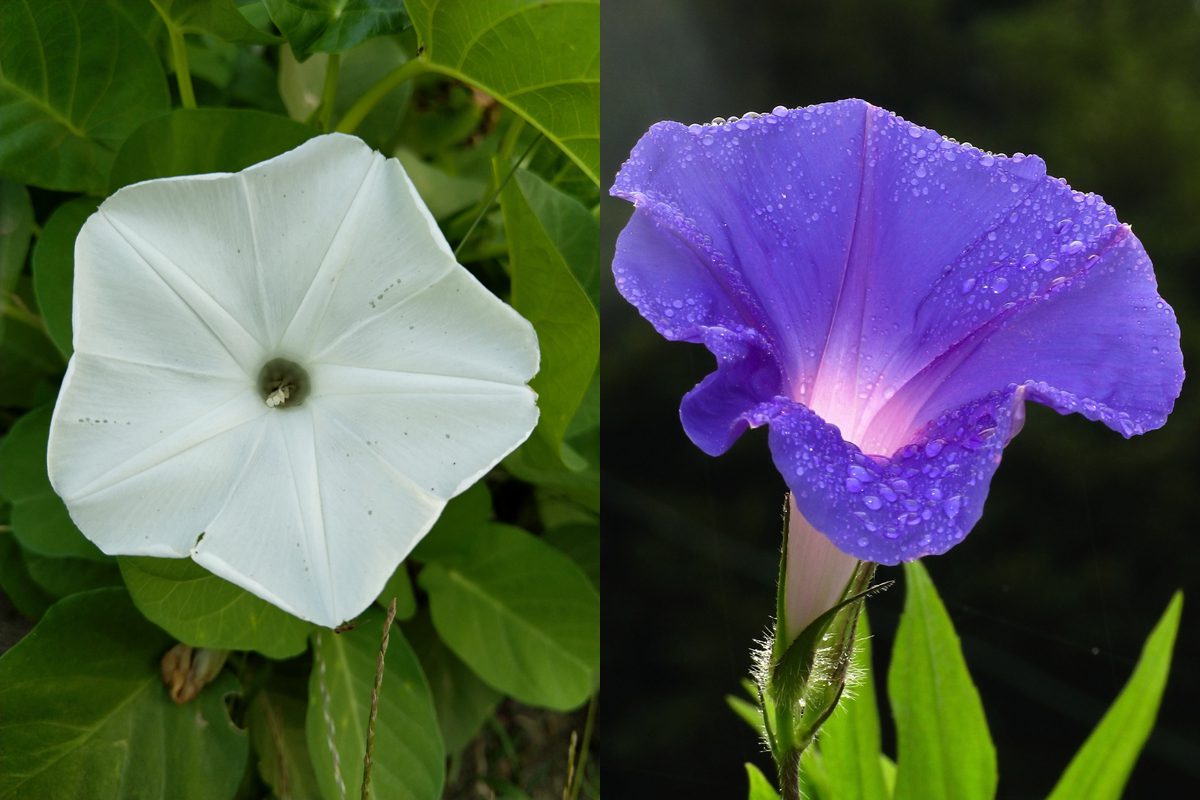
Morning glory (Ipomoea spp.) and sweet potato (Ipomoea batatas) both belong to the Convolvulaceae family, which is also known as ‘bindweed or morning glory family‘.
- Sweet potatoes are a dicotyledonous plant known for their tuberous roots, a rich source of vitamins and minerals, and one of the few plants in the Convolvulaceae family cultivated for their edible parts.
- Morning glory is a genus of several hundred species that are known for their showy, trumpet-shaped flowers that typically bloom in the morning, hence the common name. Unchecked, morning glory can become extremely invasive under the right conditions.
Both the sweet potato and the morning glory have climbing or sprawling growth habits. Despite one being mainly cultivated for its aesthetic value and the other for its nutritional content, their shared family ties underline the diverse utility and adaptability of plants within the Convolvulaceae family.
Other notable members of the Convolvulaceae family: Moonflower, sweet potato and railway creeper.
Okra and hibiscus

Okra (Abelmoschus esculentus) and hibiscus (Hibiscus spp.) both belong to the Malvaceae family. This diverse plant family contains over 200 genera and 4000 species.
Hibiscus is grown for its large, showy flowers which occur in a range of colours.
Okra is primarily cultivated for its edible green pots.
The five-petaled flowers of okra and hibiscus have a unique, central column structure connecting the stamen and pistil. This shared morphological trait is a key identifier of the Malvaceae family. Okra and many species of hibiscus are native to warm, tropical regions and they both thrive under similar growing conditions.
Other notable members of the Malvaceae family: Cotton, cacao and hollyhock.
Sunflower and lettuce
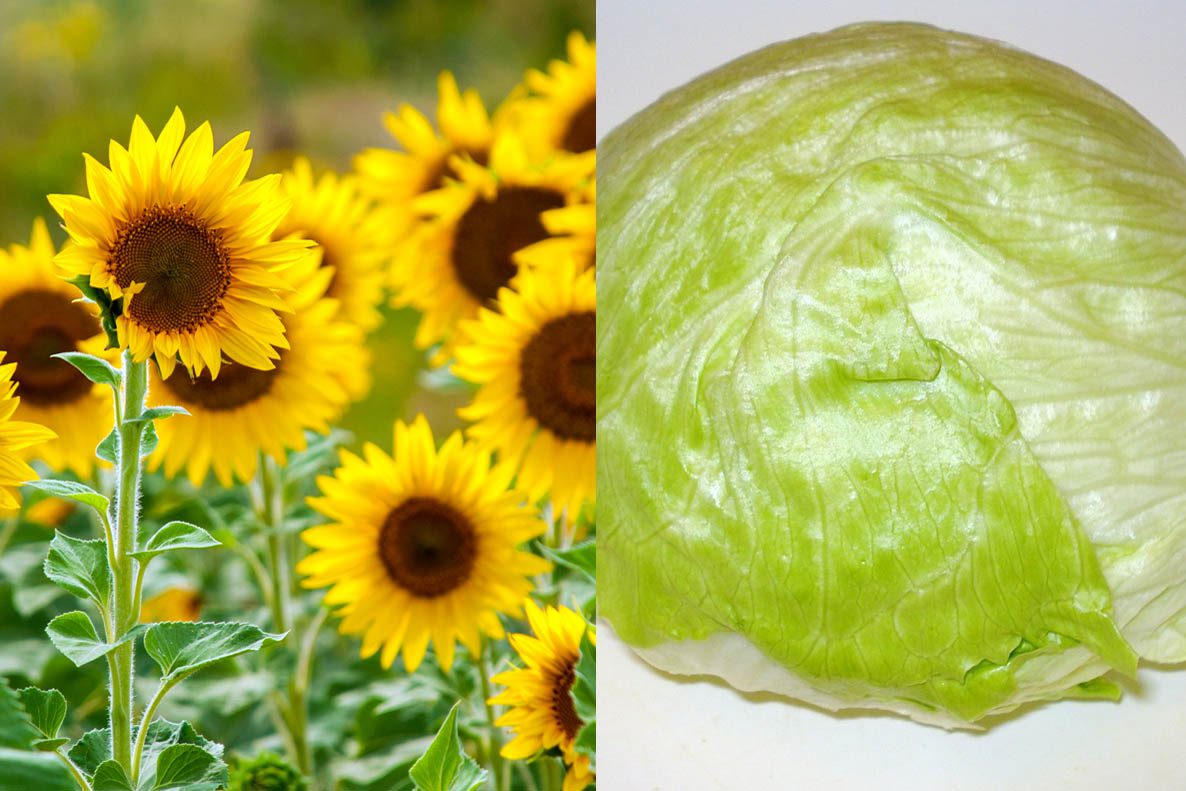
Sunflowers (Helianthus annuus) and lettuce (Lactuca sativa) may seem quite different from each other, with the former being a tall plant known for its large, bright yellow flowers, and the latter being a short leafy vegetable. However, they are both members of the same plant family, Asteraceae, also known as the sunflower or composite family. This vast plant family includes more than 23,000 species, making it one of the largest plant families on Earth.
The Asteraceae family is characterised by its unique inflorescence, or flower arrangement, known as a head or capitulum. This head is composed of numerous small individual flowers, or florets, that give the appearance of a single large flower.
- Sunflowers are grown for their bright yellow flowers and sunflower oil which is produced from the seeds. They can range in height from 30 cm to over 150 cm.
- Lettuce is a popular salad vegetable with a mild flavour and crunchy texture, used in salads and wraps. Most of us won’t see the flowers of the lettuce because it is harvested before it goes to flower. Flowering (known as bolting) leads to bitter leaves.
Other notable members of the Asteraceae family: Dandelion, daisy, marigold, artichoke and thistle.
Olive and lilac
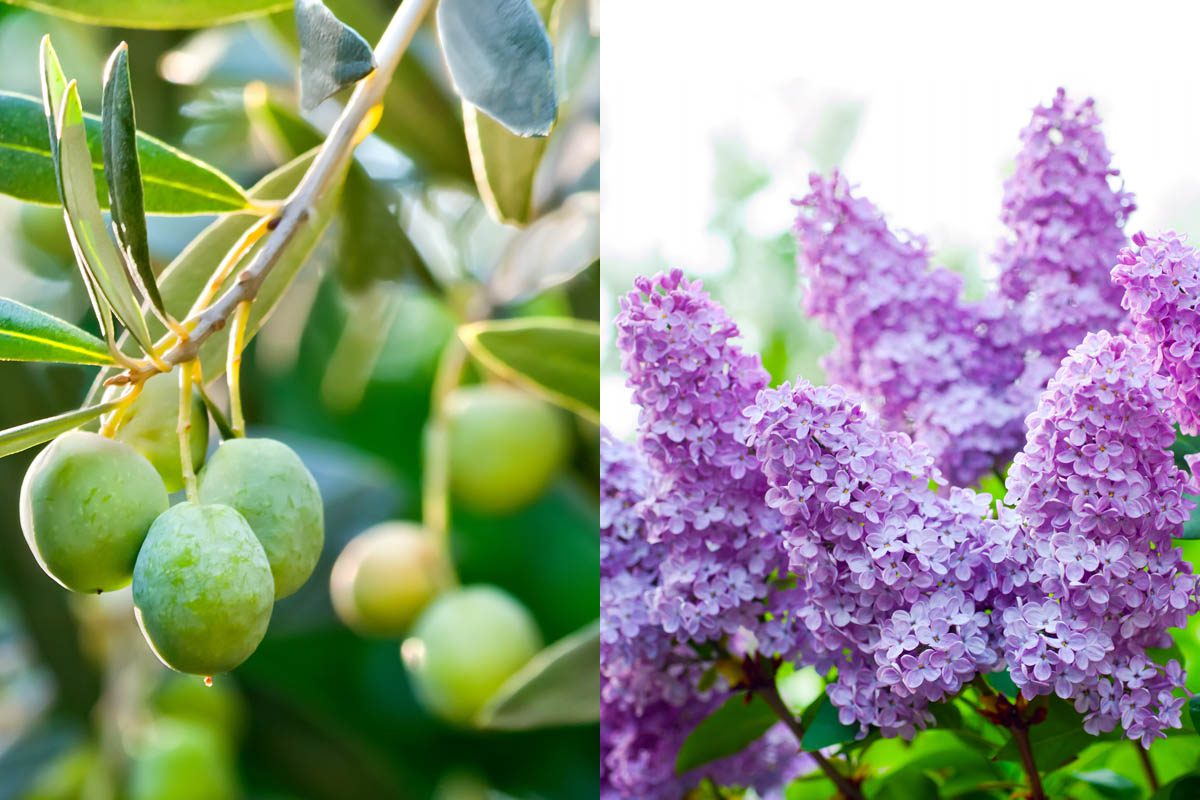
Lilac (Syringa vulgaris) and olive (Olea europaea) belong to the same plant family, Oleaceae. This diverse family, also known as the olive family, contains about 24 genera with about 700 species of flowering plants. The family is cosmopolitan in distribution, existing on all continents except Antarctica. Plants in the Oleaceae family exhibit a wide range of forms, including trees, shrubs, and climbers.
- Olives are evergreen trees native to the Mediterranean region that are renowned for their fruit and oil which have a number of health benefits. The fruits (olives) consumed either green or purple are consumed in various forms such as Greek salad, antipasto and pizza.
- Lilac is an ornamental plant grown for its highly scented lilac or white flowers which grow in racemes.
Other notable members of the Oleaceae family: Osmanthus, common jasmine and privet.
Mango and Virginia creeper
At first, the connection between the tropical mango tree (Mangifera indica) and the North American vine known as Virginia Creeper (Parthenocissus quinquefolia) might seem elusive. Both plants are part of the Sapindaceae family which encompasses about 135 genera and 1,600 species. This extensive family represents a wide array of plant forms and adaptations, spanning from the tropics to temperate regions.
- The mango is a tropical fruit-bearing tree, widely cultivated for its juicy, sweet fruit. Originally native to South Asia, the mango tree is now grown in many tropical and subtropical regions worldwide due to its popular fruit and its decorative, glossy foliage.
- Virginia creeper is a fast-growing deciduous vine, native to eastern and central North America. Green leaves appear in spring after a winter dormancy but turn to a vibrant red in autumn. Virginia creeper is often used as an ornamental plant to cover walls and fences.
Other notable members of the Oleaceae family: Horse chestnuts, maples and lychees.
Cranberry and blueberry
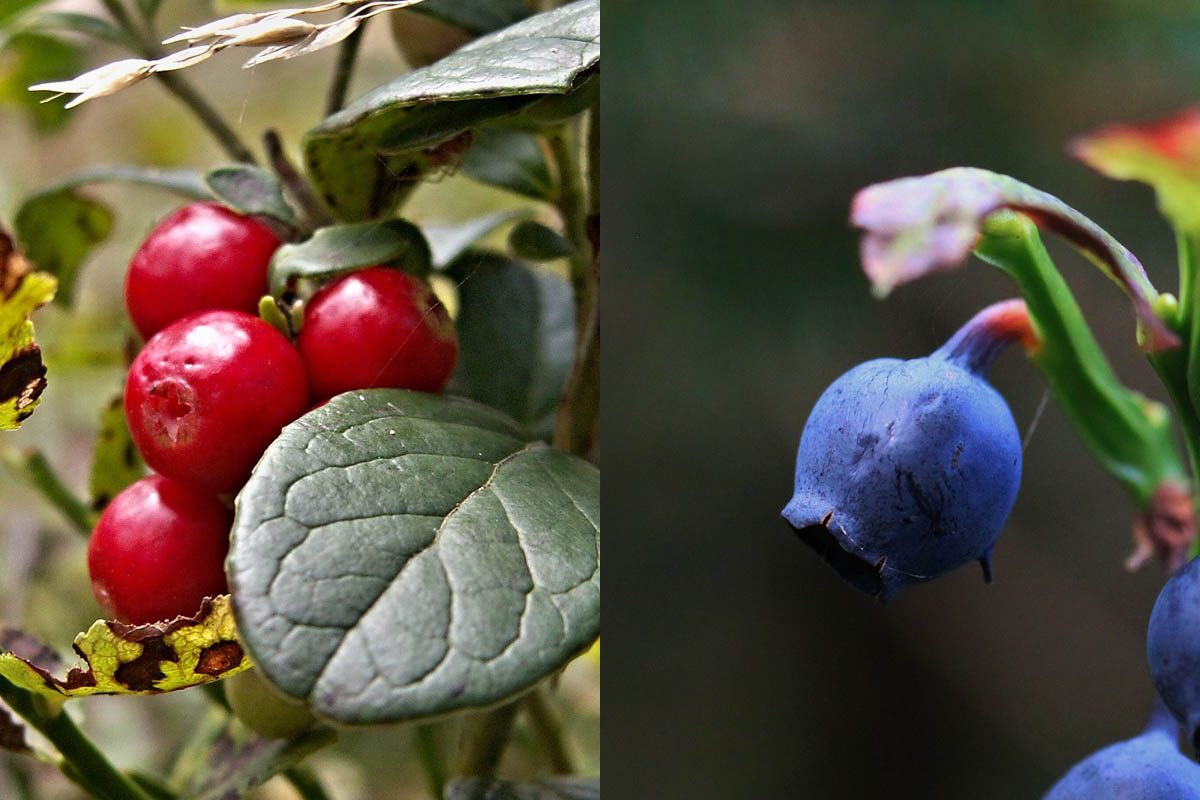
Despite their obvious differences in colour, taste, and texture, cranberries and blueberries are both members of the Ericaceae family, specifically within the Vaccinium genus. This family is characterised by flowering plants often found in acidic or infertile growing conditions. The Vaccinium genus itself is diverse, encompassing a wide variety of species that range from low-growing shrubs to small trees. Both cranberries and blueberries have evolved to produce antioxidant-rich, brightly coloured fruits known as epigynous or false berries.
- Cranberries are evergreen shrubs native to North America that produce small, red fruits. The tart fruit is a staple in Thanksgiving and Christmas feasts and is used to make sauces, and juices. Cranberries also have a number of health benefits due to their high vitamin C content.
- Blueberries are hardy shrubs native to North America that are grown for their small, sweet, and mildly tart berries. These berries are a rich source of antioxidants, Vitamin C, and dietary fibre.
Other notable members of the Ericaceae family: Rhododendrons, heather and pieris.
Strawberry and avocado

Strawberries (Fragaria × ananassa) and avocados Persea americana) are part of the Rosaceae family, often referred to as the rose family. This family comprises a wide variety of plants including herbs, shrubs, and trees. Both the strawberry and the avocado are angiosperms (flowering plants).
- Avocado is an evergreen tree native to central Mexico known for its nutrient-dense green berries. Avocadoes contain high levels of monounsaturated fats which can lower cholesterol. Culinary uses for avocado include raw, salads and guacamole.
- Strawberries are a perennial plant native to Northern Europe. Strawberries are eaten raw in fruit salads, on their own or used for marmalade.
Other notable members of the Rosaceae family: Rose, apple, cherries, geum.
Coffee and gardenia
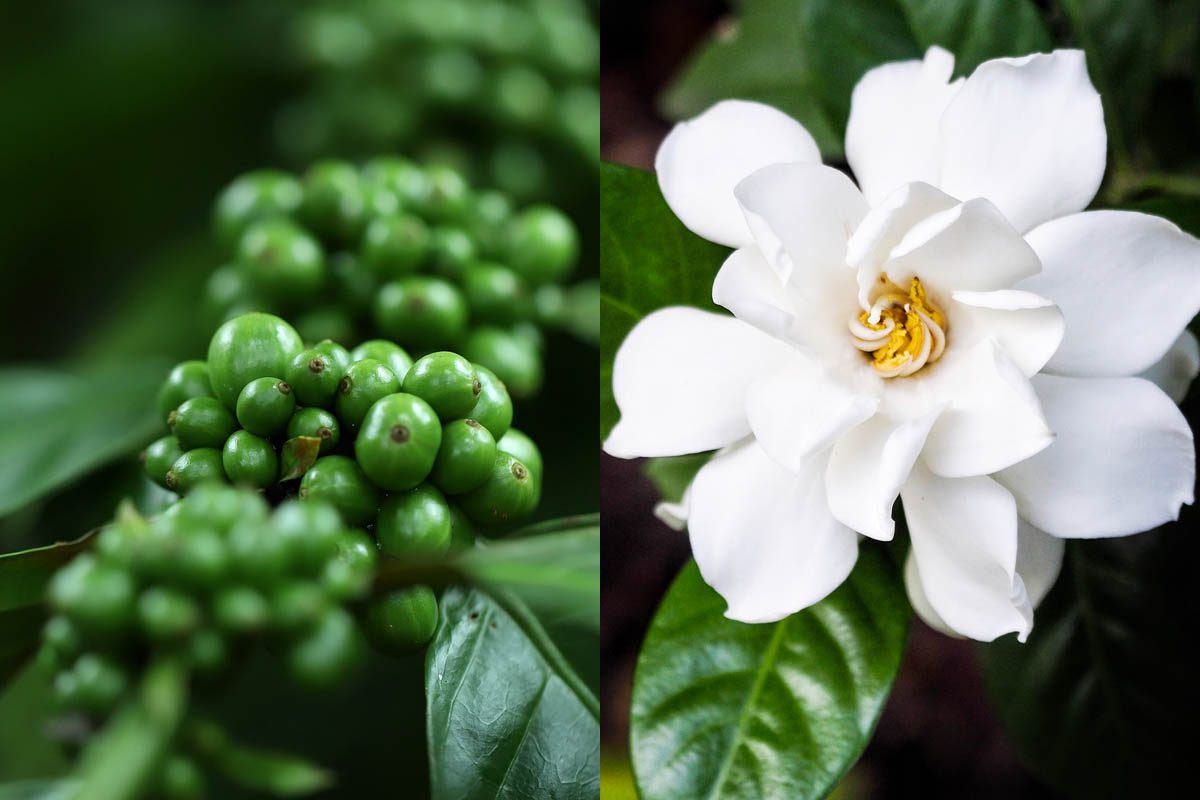
Coffee (Coffea species) and gardenia (Gardenia species) both belong to the Rubiaceae family, also known as the coffee, madder, or bedstraw family. This large plant family contains over 13,000 species and is characterised by simple, opposite leaves and interpetiolar stipules.
- Coffee is a flowering plant native to tropical Africa popular for its seeds or “beans”. Coffee beans contain caffeine, which is a central nervous stimulant. Its purpose is to protect the beans from herbivory and is now one of the most popular beverages on the planet.
- Gardenia is a genus of flowering plants within the Rubiaceae family, grown for their fragrant, showy white flowers and attractive green foliage.
Other notable members of the Rubiaceae family: Ixora and rubia.
How is it possible related plants can be native to different parts of the world?
It’s hard to imagine how the Australian flannel flower can be related to the carrot or the mango to Virginia creeper, but there are a number of ways plants have evolved from a common ancestor into the species we now know.
- Plate Tectonics: Millions of years ago, the landmass on Earth was a single supercontinent known as Pangaea. Over time, tectonic forces caused Pangaea to split apart into separate continents and move to their current locations. Plants living on Pangaea became separated and evolved independently, to form new species in response to their unique environments.
- Seed Dispersal: Seeds can be carried great distances by wind, water, and animals. Fruits eaten by birds can have their seeds distributed through the bird’s droppings. Some seeds can float on water, spreading plants to new areas via rivers and ocean currents. Some plants have evolved seeds that can withstand the digestive tracts of animals, facilitating their spread over large areas.
- Human Intervention: Humans have been instrumental in spreading plants across the globe. As our ancestors migrated, they brought with them plants and seeds. Trade and colonisation also played a significant role in distributing plant species far from their original habitats, especially in modern times.
- Evolution and Adaptation: Over long periods, plants can evolve to adapt to different climates, soils, and ecosystems, leading to the development of new species. This is often driven by natural selection, where certain traits become more common in a population because they provide a survival advantage in a particular environment.
These processes explain why related plants can be found in widely separated regions today. For instance, similar conditions in different parts of the world can lead to parallel evolution, where unrelated plants may evolve similar traits, making them look deceptively related. In contrast, closely related plants may look quite different if they have adapted to disparate environments.
Julia is a writer and landscape consultant from Wollongong with a love of horticulture. She had been an avid gardener for over 30 years, collects rare variegated plants and is a home orchardist. Julia is passionate about learning and sharing her knowledge of plant propagation and plant toxicology. Whether it’s giving advice on landscape projects or sharing tips on growing, Julia enjoys helping people make their gardens flourish.
